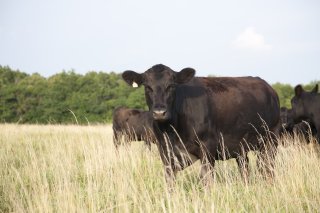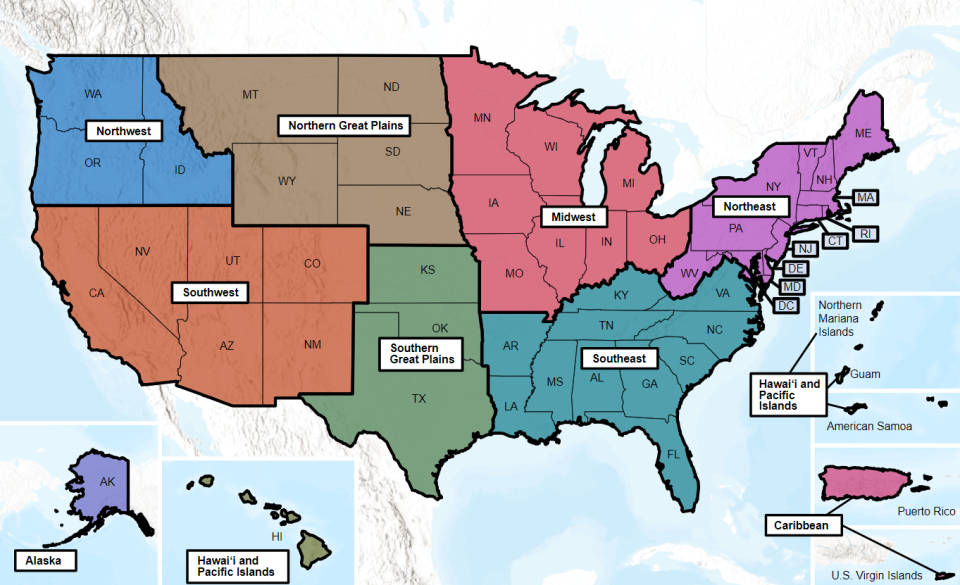Climate Change Connections: Oklahoma (Cattle Ranching)
Climate change is impacting all regions and sectors of the United States. The State and Regional Climate Change Connections resource highlights climate change connections to culturally, ecologically, or economically important features of each state and territory. The content on this page provides an illustrative example. As climate change will affect each state and territory in diverse ways, this resource only describes a small portion of these risks. For more comprehensive information about regional climate impacts, please visit the Fifth National Climate Assessment and Climate Change Impacts by Sector.
On this page:
Introduction: Cattle Ranching—A Crucial Industry for Oklahoma

Oklahoma is home to rolling hills and broad plains covered with grasslands and prairie.1 These conditions create an ideal environment for cattle ranching, the top agricultural commodity in the state.2 The Oklahoma cattle industry generates substantial revenue for the state, totaling more than $4.5 billion in 2022.2 Nationally, Oklahoma ranks in the top five states for cattle production and is second in beef cattle production.3
Climate Impacts: Warming Temperatures Can Affect Animal Health and Have Economic Implications for Ranchers
Temperatures in Oklahoma and across the southern Great Plains region are expected to get warmer over the coming century and the number of extremely hot days is expected to increase.4,5 High temperatures can cause cattle to experience heat stress, which impacts both animal welfare and the cattle ranching industry. Cattle typically respond to high temperatures by being less active, increasing panting, and drinking more water.6 In hotter temperatures, cows may eat less food, which can impact their growth rates.7 Studies have also found that prolonged heat stress can affect meat quality.8 Animal immune systems are affected by heat stress, and prolonged periods of high temperatures can make livestock more vulnerable to diseases.8 This is not only a concern for animal health but also for cattle ranchers who may need to increase their operating costs to treat sick cattle and for consumers who are looking for quality beef.
High temperatures can be deadly for livestock.9 Feedlot cattle are especially vulnerable to high temperatures as they are confined to spaces for feeding, which can limit their ability to move to cooler areas or find shade.6 In June 2022, thousands of cattle died of heat stress in feedlots in Oklahoma’s neighboring state of Kansas during a heat wave that was compounded by high humidity and low wind speeds.5 Large herd die-offs like these can have major economic implications for ranchers, as each cow can be worth around $2,000.10
Climate Impacts: Droughts Affect Water Availability and Vegetation
Droughts are a common and severe issue in Oklahoma that can greatly impact cattle and the ranching industry.4 As climate change has caused average temperatures to rise, the Earth’s water cycle has sped up through an increase in the rate of evaporation from soil and transpiration from plants. Higher temperatures can accelerate soil moisture loss, meaning droughts in Oklahoma are expected to become more intense.4

Droughts can directly affect the availability and quality of the plants, or forage, that cattle on rangelands eat. Forage availability in the Southern Plains is expected to decrease over the coming century.11 Warming and drying in the Southern Plains region are also expected to increase woody plants’ encroachment into grasslands, thereby reducing the availability of the grasses cattle feed on.12 Droughts can also decrease the nutritional quality of forage, which can affect cattle growth rates.8,13
During drought years, cattle face less nutritious food at a time when forage quantity is already limited. This can increase operating costs and reduce profits for cattle ranchers as they may be required to purchase supplemental feed or sell off cattle before they are market-ready.11 In 2011, a severe drought in Oklahoma led to losses in livestock and crop production.14 High hay prices and dried-out watering holes forced some cattle ranchers to sell off their herds.14
Taking Action: Preparing for Ranching in a Warmer, Drier Climate
Addressing climate change requires reducing greenhouse gas emissions while preparing for and protecting against current and future climate impacts. Communities, public officials, and individuals in every part of the United States can continue to explore and implement climate adaptation and mitigation measures. The livestock industry both experiences climate impacts and contributes to greenhouse gas emissions, particularly methane emissions.15 As a source of greenhouse gas emissions, the cattle ranching industry is in a unique position to increase resilience to the same changes in climate it contributes to.15 Across the Midwest, ranchers and natural resource managers are embracing strategies for dealing with warming temperatures and drought, including:
- Flexible stocking and resilient breeds. Many cattle ranchers are already using an adaptive strategy known as flexible stocking. Ranchers buy more cattle during wet years to make use of the abundant forage available and sell cattle during dry years when less forage is available. This can be a way to maximize profits under variable climatic conditions. This strategy is complex and requires additional labor, which may be costly for some ranching operations.12 Some cattle breeds are also more tolerant to heat stress than others, and ranchers may switch to these breeds as an adaptation strategy in response to hotter and drier weather.8,12
- Healthy soil management. Many ranchers already embrace rotational grazing practices that involve moving livestock between pastures. The rest from grazing allows vegetation to grow deeper roots, which can increase nutrient storage and promote healthier soil systems. Healthier soils can help with carbon sequestration thereby providing important mitigation benefits.16 Approaches like agroforestry, which incorporates trees and shrubs into farm systems, can promote healthy soils and provide shady areas to mitigate heat stress for grazing livestock.15,17
To learn more about climate change impacts in Oklahoma and the southern Great Plains region, see Chapter 26 of the Fifth National Climate Assessment.
Related Resources
- Climate Change Impacts on Agriculture and Food Supply (EPA)
- EPA Climate Change Indicators: Drought
- EPA Climate Change Indicators: U.S. and Global Temperatures
- EPA Climate Change Indicators: Seasonal Temperature
- Oklahoma State Climate Summary 2022 (NOAA)
- Fifth National Climate Assessment: Chapter 11: Agriculture (U.S. Global Change Research Program)
References
1 Tyrl, R. J., Bidwell, T. G., Masters, R. E., Elmore, R. D., & Weir, J. R. (2017). Oklahoma’s native vegetation types. Natural Resource Ecology and Management, Oklahoma Cooperative Extension Service, Oklahoma State University. https://extension.okstate.edu/fact-sheets/print-publications/e/oklahomas-native-vegetation-types-e-993.pdf
2 U.S. Department of Agriculture. (2023). State fact sheets: Oklahoma. Retrieved December 6, 2023, from https://data.ers.usda.gov/reports.aspx?StateFIPS=40&StateName=Oklahoma&ID=17854
3 U.S. Department of Agriculture National Agricultural Statistics Service. (2023). Cattle. https://downloads.usda.library.cornell.edu/usda-esmis/files/h702q636h/ms35vn48m/fj237f291/catl0123.pdf
4 Frankson, R., Kunkel, K. E., Stevens, L. E., Champion, S. M., Stewart, B. C., & Nielsen-Gammon, J. (2022). Oklahoma state climate summary 2022 (NOAA Technical Report NESDIS 150-OK). NOAA National Environmental Satellite, Data, and Information Service. https://statesummaries.ncics.org/chapter/ok/
5 McPherson, R. A., Fay, P. A., Alvarez, S. G., Bertrand, D., Broadbent, T. L., Bruno, T., Fares, A., McCullough, B., Moore, G. W., Moorhead, B., Patiño, L., Petersen, A., Smith, N. G., Steiner, J. L., Taylor, A., & Warziniack, T. (2023). Ch. 26. Southern Great Plains. In A. R. Crimmins, C. W. Avery, D. R. Easterling, K. E. Kunkel, B. C. Stewart, & T. K. Maycock (Eds.), Fifth National Climate Assessment. U.S. Global Change Research Program. https://doi.org/10.7930/NCA5.2023.CH26
6 Summer, A., Lora, I., Formaggioni, P., & Gottardo, F. (2019). Impact of heat stress on milk and meat production. Animal Frontiers, 9(1), 39–46. https://doi.org/10.1093/af/vfy026
7 Yadav, B., Singh, G., Verma, A. K., Dutta, N., & Sejian, V. (2013). Impact of heat stress on rumen functions. Veterinary World, 6(12), 992–996. https://doi.org/10.14202/vetworld.2013.992-996
8 Cheng, M., McCarl, B., & Fei, C. (2022). Climate change and livestock production: A literature review. Atmosphere, 13(1), Article 1. https://doi.org/10.3390/atmos13010140
9 Burhans, W. S., Rossiter Burhans, C. A., & Baumgard, L. H. (2022). Invited review: Lethal heat stress: The putative pathophysiology of a deadly disorder in dairy cattle. Journal of Dairy Science, 105(5), 3716–3735. https://doi.org/10.3168/jds.2021-21080
10 Hegeman, R. (2022, June 16). Heat stress blamed for thousands of cattle deaths in Kansas. AP News. https://apnews.com/article/kansas-cattle-heat-wave-deaths-643f651f1b6118ee6ae4c6833176ce04
11 Klemm, T., Briske, D. D., & Reeves, M. C. (2020). Vulnerability of rangeland beef cattle production to climate‐induced NPP fluctuations in the US Great Plains. Global Change Biology, 26(9), 4841–4853. https://doi.org/10.1111/gcb.15202
12 Steiner, J. L., Briske, D. D., Brown, D. P., & Rottler, C. M. (2018). Vulnerability of Southern Plains agriculture to climate change. Climatic Change, 146(1), 201–218. https://doi.org/10.1007/s10584-017-1965-5
13 Briske, D. D., Ritten, J. P., Campbell, A. R., Klemm, T., & King, A. E. H. (2021). Future climate variability will challenge rangeland beef cattle production in the Great Plains. Rangelands, 43(1), 29–36. https://doi.org/10.1016/j.rala.2020.11.001
14 National Weather Service. (2012). 2011 Drought. Tulsa, OK Weather Forecast Office. Retrieved December 4, 2023, from https://www.weather.gov/tsa/weather-event_2011drought
15 Bolster, C. H., Mitchell, R., Kitts, A., Campbell, A., Cosh, M., Farrigan, T. L., Franzluebbers, A. J., Hoover, D. L., Jin, V. L., Peck, D. E., Schmer, M. R., & Smith, M. D. (2023). Ch. 11. Agriculture, food systems, and rural communities. In A. R. Crimmins, C. W. Avery, D. R. Easterling, K. E. Kunkel, B. C. Stewart, & T. K. Maycock (Eds.), Fifth National Climate Assessment. U.S. Global Change Research Program. https://doi.org/10.7930/NCA5.2023.CH11
16 USDA Climate Hubs. (n.d.). Rotational grazing for climate resilience. Retrieved February 22, 2024, from https://www.climatehubs.usda.gov/hubs/international/topic/rotational-grazing-climate-resilience
17 U.S. Department of Agriculture. (n.d.). Agroforestry. Retrieved July 8, 2024, from https://www.usda.gov/topics/forestry/agroforestry

